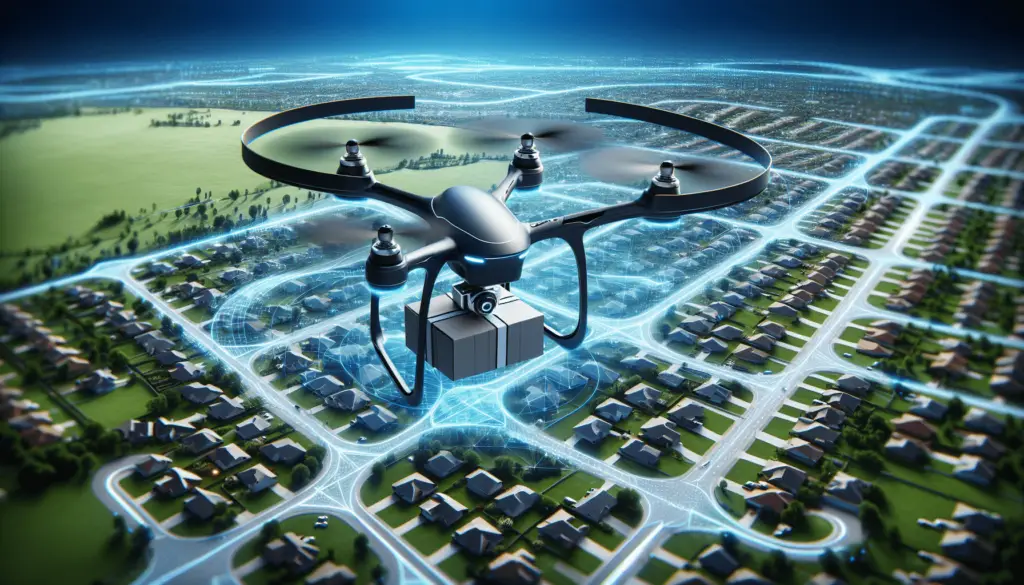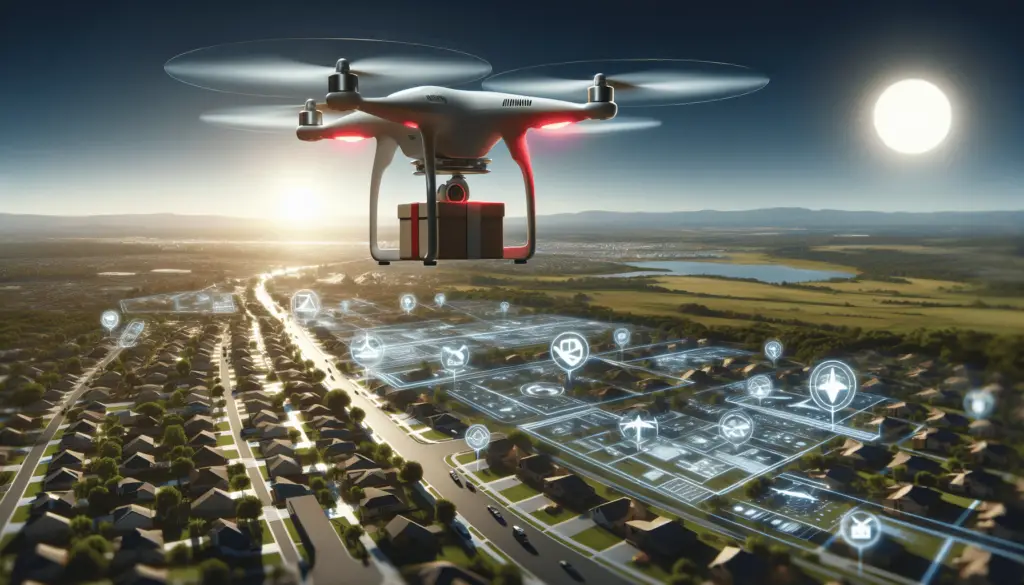Have you ever considered using drones for surveillance and delivery as a modern prepper? Drones can be incredibly useful tools for keeping an eye on your surroundings and getting supplies without having to leave your shelter. In this guide, we will explore the ins and outs of using drones for both surveillance and delivery purposes, so you can be well-prepared for any situation that may arise.

Understanding the Basics of Drones
Drones, also known as unmanned aerial vehicles (UAVs), are aircraft that can be controlled remotely or autonomously. They come in various shapes and sizes, from small quadcopters to large fixed-wing models. Understanding the basics of how drones work and operate is crucial before utilizing them for surveillance and delivery tasks.
When you operate a drone, you are essentially using a controller to send commands to the aircraft. Drones are equipped with sensors, cameras, and GPS units to provide information and navigate their surroundings. It’s essential to familiarize yourself with the controls and functionalities of your drone to ensure safe and effective operation.
Choosing the Right Drone for Your Needs
Before you can start using drones for surveillance and delivery, you need to select the right one for your specific requirements. There are several factors to consider when choosing a drone, including flight time, payload capacity, range, and camera quality.
For surveillance purposes, you’ll want a drone with a high-resolution camera that can capture clear images and videos from a distance. Look for models with a gimbal stabilizer to ensure smooth footage even in windy conditions. Additionally, consider drones with longer flight times and range capabilities for extended surveillance missions.
When it comes to delivery, payload capacity is crucial. You’ll need a drone that can carry the necessary supplies, such as food, medical supplies, or communication devices. Make sure to check the drone’s payload capacity and ensure it aligns with your specific needs.
Mastering Drone Operation Techniques
Operating a drone effectively requires mastering various techniques to ensure smooth flights and accurate surveillance or delivery tasks. Practice is key when it comes to honing your drone operation skills.
Start by familiarizing yourself with the controller and the different commands needed to maneuver the drone. Practice flying in open spaces to get a feel for the controls and how the drone responds to your inputs. Experiment with different flight modes, such as manual, altitude hold, and GPS mode, to understand how each one affects the drone’s behavior.
When it comes to surveillance, practice flying the drone at different altitudes and distances to capture the best possible footage. Learn how to adjust the camera settings to optimize image quality and ensure clear visibility of your surroundings. For delivery tasks, practice dropping payloads accurately and safely to designated locations.

Safety Precautions and Regulations
As a modern prepper using drones for surveillance and delivery, it’s crucial to prioritize safety and adhere to regulations to avoid accidents and legal issues. Familiarize yourself with the following safety precautions and regulations before operating a drone:
- Always fly in open areas away from people, buildings, and obstacles to minimize the risk of collisions.
- Register your drone with the appropriate authorities and display your registration number on the aircraft.
- Follow local regulations and airspace restrictions to avoid fines and penalties.
- Keep your drone within line of sight at all times to maintain control and avoid accidents.
- Conduct pre-flight checks to ensure the drone is in proper working condition and the batteries are fully charged.
By following these safety precautions and regulations, you can operate your drone safely and responsibly for surveillance and delivery tasks.
Planning Surveillance Missions with Drones
Surveillance is a critical aspect of prepping, allowing you to monitor your surroundings and stay informed about potential threats or changes in the environment. Using drones for surveillance missions can enhance your situational awareness and provide valuable intelligence from a bird’s eye view.
When planning surveillance missions with drones, consider the following factors:
- Identify high-risk areas or points of interest that require monitoring.
- Determine the optimal flight path and altitude for capturing clear and comprehensive footage.
- Schedule surveillance missions during daylight hours for better visibility.
- Check the weather conditions and wind speeds before launching the drone.
- Set waypoints and markers to guide the drone along the designated route.
By carefully planning your surveillance missions and following these guidelines, you can maximize the effectiveness of your drone for gathering crucial information and maintaining security.
Enhancing Surveillance Capabilities with Advanced Features
Many modern drones come equipped with advanced features and capabilities that can enhance their surveillance capabilities and make your prepping efforts more efficient. Some of these features include:
- Autonomous flight modes that allow the drone to follow a predetermined route or circle around a specific area.
- Intelligent tracking systems that can lock onto and follow moving subjects automatically.
- Thermal imaging cameras for detecting heat signatures and identifying living beings in low-light conditions.
- Night vision capabilities for conducting surveillance missions in complete darkness.
- Live streaming options to view real-time footage from the drone’s camera on a mobile device.
By leveraging these advanced features, you can take your surveillance capabilities to the next level and stay one step ahead of potential threats or emergencies.
Implementing Drone Delivery Strategies
In addition to surveillance, drones can also be used for delivering essential supplies and resources during emergencies or disasters. Implementing drone delivery strategies can help you provide aid to those in need and maintain communication lines when traditional methods are unavailable.
When implementing drone delivery strategies, consider the following:
- Identify the types of supplies or resources that need to be delivered, such as food, water, first aid kits, or batteries.
- Establish secure drop-off locations and landing zones for the drone to safely deliver the payloads.
- Test the delivery process in various conditions to ensure accuracy and reliability.
- Consider using multiple drones for simultaneous deliveries to expedite the process.
- Monitor battery life and flight times to plan delivery missions effectively.
By strategically implementing drone delivery strategies and fine-tuning the process, you can streamline your prepping efforts and ensure timely assistance to those in need.
Overcoming Challenges and Limitations
While drones offer numerous benefits for surveillance and delivery tasks, they also come with challenges and limitations that must be addressed to maximize their effectiveness. Some common challenges include:
- Limited battery life and flight times that restrict the duration of surveillance missions and delivery operations.
- Weather conditions such as rain, wind, or snow can impact the drone’s performance and prevent safe flights.
- Signal interference or GPS signal loss can disrupt the drone’s navigation and communication systems.
- Payload capacity limitations may restrict the types and quantities of supplies that can be delivered.
- Regulatory restrictions and airspace limitations can hinder drone operations in certain areas.
To overcome these challenges and limitations, consider implementing the following strategies:
- Invest in additional batteries and charging solutions to extend flight times and increase mission durations.
- Monitor weather conditions closely and plan surveillance or delivery missions accordingly to avoid adverse effects.
- Use signal boosters or antennas to enhance signal strength and minimize signal interference.
- Conduct regular maintenance checks on the drone to ensure optimal performance and address any issues promptly.
- Stay informed about local regulations and airspace restrictions to comply with legal requirements and avoid penalties.
By proactively addressing these challenges and limitations, you can make the most of your drone for surveillance and delivery tasks as a modern prepper.
Conclusion
In conclusion, drones can be powerful tools for modern preppers looking to enhance their surveillance and delivery capabilities. By understanding the basics of drone operation, choosing the right model for your needs, mastering operation techniques, and following safety precautions, you can effectively utilize drones for prepping purposes.
Whether you’re conducting surveillance missions to monitor your surroundings or delivering essential supplies to those in need, drones offer a versatile and efficient solution for modern prepping challenges. By planning missions, leveraging advanced features, and overcoming challenges, you can take your prepping efforts to the next level with the help of drones.
Remember to stay informed about regulations, practice responsible drone operation, and continuously improve your skills to make the most of this valuable tool in your prepping arsenal. With the right approach and preparation, drones can significantly enhance your ability to thrive in any situation as a modern prepper.
